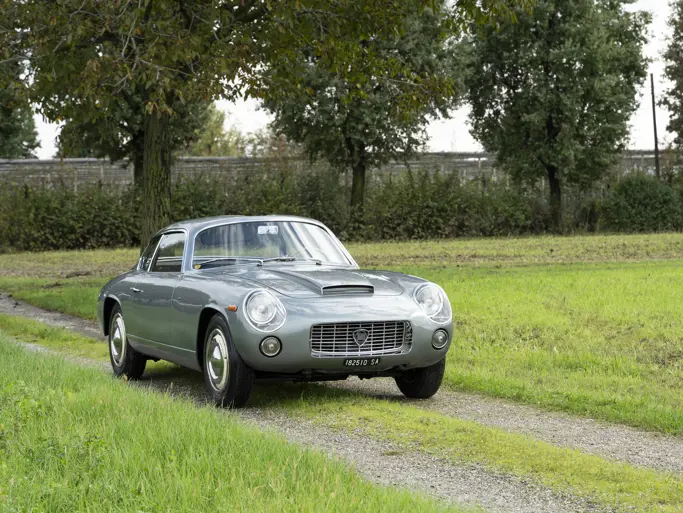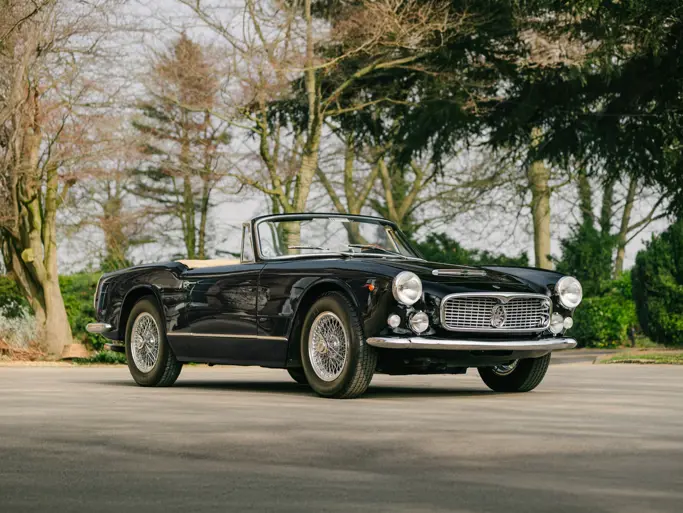1961 Ferrari 250 GTE 2+2 Series I by Pininfarina
{{lr.item.text}}
€252,000 EUR | Sold
{{bidding.lot.reserveStatusFormatted}}
- Fascinating known history; a connoisseur’s favoured driver
- Participant on the Ferrari Le 250 Tornano a Casa Tour in 2014
- Documented in the 250 GTE Register
- Single ownership for the last 25 years
- Fascinant historique connu, une machine de connaisseur
- Participant au 250 Tornano a Casa Tour en 2014
- Un seul propriétaire depuis 25 ans
240 bhp, 2,953 cc SOHC V-12 engine with three Weber carburettors, four-speed manual transmission with overdrive, front double-wishbone suspension and rear semi-elliptic leaf springs, and front and rear disc brakes. Wheelbase: 2,600 mm.
Moteur V-12, 2 953 cm3, 240 ch, 1 ACT par banc, trois carburateurs Weber, boîte de vitesses manuelle à quatre rapports avec overdrive, suspension avant par doubles triangles et arrière par ressorts à lames semi-elliptiques, quatre freins à disque. Empattement: 2 600 mm
Tifosi and other race fans alike got their first look at Ferrari’s newest addition to the 250 series of cars at the 1960 24 Hours of Le Mans. Surprisingly, this new car was not on the race track battling it out with the likes of Aston Martin’s and Jaguar’s newest sports racers; it was being piloted by the course marshal instead. Keen eyes were quick to notice that this car had not two seats but four. Ferrari had produced several special-order 2+2s in conjunction with Ghia, Touring, and Vignale for demanding clients in the past, but this would be the marque’s first car of this type ever produced by the company.
Ferrari formally introduced the course marshal’s car to the public just six months after the 24 Hours of Le Mans, at the 1960 Paris Salon. As the 250 GTE was the first four-seater ever to be “mass-produced” by the company, it represented Ferrari’s ever-increasing attention to their road car division. The 250 GTE shared the same wheelbase as the legendary 250 GT LWB Tour de France and was equipped with a similar Colombo V-12. It was capable of a top speed of just over 150 mph, proving to more traditional Ferrari clients that performance would never be compromised in a car from Maranello.
In order to make the car comfortable for four people, Ferrari’s engineers had to make several changes to the existing 250 platform, which included moving the car’s engine forward on the chassis and widening the track of all four wheels. This made the 250 GTE much more comfortable for those sitting in the back, as well as for those sitting in the front. With coachwork designed by Pininfarina, the 250 GTE’s design was not only that of stately elegance, but it was also instantly recognisable as a Ferrari. Ferrari produced 954 examples and three slightly different model variants over its four years of production.
CHASSIS NUMBER 2889 GT
The 250 GTE 2+2 offered here was completed in October 1961. It was finished in Medium Silver Metallic with a blue interior and was first registered in Rome the following month. In 1972, it was imported to the United States, where it enjoyed a period of West Coast ownership in the care of enthusiasts Robert J. Trier and Redge H. Martin. It was exported back to Europe in 1988, where it was purchased by well-known Ferrari collector Stuart Anderson as a gift for his girlfriend. Her unfortunate sudden passing resulted in the sale of the 250 GTE in February 1993 to Mark Shannon, who in turn resold it to Ernie Fleischer, of Richmond, British Columbia.
The car was then the property of Yale Shap, of South Surrey, British Columbia, for some years. In 1998, Mr Shap reported to the 250 GTE Registry that “normal push/pull console switches have been changed to toggles, either at the factory or shortly after purchase. All trim bits etc. are as original, including leather cold weather radiator blind. In changing the thermostat recently, I found the original stamped August 1961”. Amusingly, Shap noted that, in November 1997, the car had been driven by actor Robert Culp in an episode of the cult classic television series Viper.
The current owner purchased the car in British Columbia and removed the engine, rebuilt it, and used it as a spare for his California Spider. In 2013, the engine was taken out of the California Spider and returned to the 250 GTE, which the owner used on the Ferrari Le 250 Tornano a Casa Tour in the summer of 2014.
The car was refinished years ago in its present metallic maroon, and it shows some wear to the paint throughout, as would be expected of a Ferrari that has been used and enjoyed for decades. Much of the chrome trim appears to be original, as does the interior, including the original blue seats that were re-dyed black by a prior owner. Overall, the car appears just as Mr Shap once described it, and it would serve as an ideal car for continued touring use or as the basis for a fresh restoration of what will be, when finished, an outstanding example of the 250 GTE 2+2. The opportunities are endless!
Les tifosi comme les autres passionnés de course automobile virent pour la première fois la petite nouvelle de la famille 250 aux 24 Heures du Mans 1960. Mais, à l’étonnement général, cette nouvelle voiture n’était pas sur la piste en lutte avec ses plus récentes rivales de chez Aston Martin et Jaguar. Elle était simplement pilotée par le directeur de course lui-même. Les plus perspicaces découvrirent vite que la voiture n’avait pas deux places, mais quatre. Ferrari avait déjà produit sur commande quelques 2+2 en coopération avec Ghia, Touring ou Vignale pour des clients exigeants, mais le dernière née allait être la première voiture de ce type de la marque.
Officiellement, Ferrari présenta la voiture du directeur de course au public six mois seulement après les 24 Heures du Mans, au salon de Paris 1960. Du fait que la 250 GTE était la première quatre-places jamais produite « en série » par la firme, elle démontra l’intérêt croissant que Ferrari portait désormais aux routières. La 250 GTE reprenait le même empattement que celui de la légendaire 250 GT « châssis long » Tour de France et un moteur V-12 Colombo similaire. Elle pouvait dépasser légèrement 240 km/h, démontrant à la clientèle plus traditionnelle de Ferrari que la performance ne serait jamais négligée à Maranello.
Pour assurer le confort de quatre personnes, les ingénieurs de Ferrari durent introduire plusieurs modifications à la plate-forme 250 existante dont l’avancement du moteur dans le châssis et l’élargissement des voies. Les occupants arrière bénéficièrent donc d’un confort supérieur comme ceux de l’avant. Avec une carrosserie signée Pininfarina, le style de la 250 GTE n’était pas seulement marqué par une sobre élégance, mais il demeurait instantanément identifiable comme celui d’une Ferrari. Maranello en produisit 954 exemplaires en quatre années et selon trois variantes légèrement différentes.
LA CHÂSSIS N° 2889 GT
La 250 GTE offerte ici fut achevée en octobre 1961, peinte en argent moyen métallisé avec intérieur bleu, et immatriculée d’abord à Rome le mois suivant. En 1972, elle fut importée aux Etats-Unis où elle résida sur la côte ouest aux bons soins des passionnés Robert J. Trier et Redge H. Martin. Elle revint en Europe en 1988, achetée par le collectionneur de Ferrari bien connu Stuart Anderson qui l’offrit à sa compagne. Le décès soudain de cette dernière entraîna la vente de la 250 GTE en février 1993 à Mark Shannon qui la revendit à Émile Fleischer de Richmond en Colombie Britannique.
La voiture devint ensuite la propriété de Yale Shap de South Surrey, Colombie Britannique, pendant quelques années. En 1998, M. Shap fit savoir au Registre 250 GTE que les « poussoirs normaux de la console avaient fait place à des basculeurs, à l’usine ou peu de temps après l’achat. Tous les habillages et accessoires, etc sont conformes à l’origine comme l’écran de radiateur en cuir pour température très basse. En changeant récemment le thermostat, j’ai découvert que l’original était frappé Août 1961 ». Amusé, Shap nota qu’en novembre 1997, la voiture avait été conduite par l’acteur Robert Culp dans la série culte de la TV, Viper.
Le propriétaire actuel acheta la voiture en Colombie Britannique et démonta le moteur, le reconstruisit et l’utilisa comme rechange pour son Spider California. En 2013, le moteur fut extrait de la California pour retourner dans la 250 GTE que le propriétaire conduisit lors du 250 Tornano a Casa Tour à l’été 2014.
La voiture repeinte il y a quelques années dans l’actuelle teinte marron métallisé présente quelques traces d’usure de la laque comme il est normal pour une voiture qui a été utilisée et appréciée pendant des dizaines d’années. La majorité des ornements chromés semblent être d’origine comme l’intérieur y compris les sièges bleu originaux qui furent teintés en noir par un précédent propriétaire. Dans l’ensemble, la voiture apparaît telle que l’a décrite M. Shap et elle sera une voiture idéale pour le tourisme ou comme base d’une nouvelle restauration de ce qui deviendra ensuite un exemple extraordinaire de 250 GTE. Il y a toujours des opportunités.

 | Paris, France
| Paris, France


